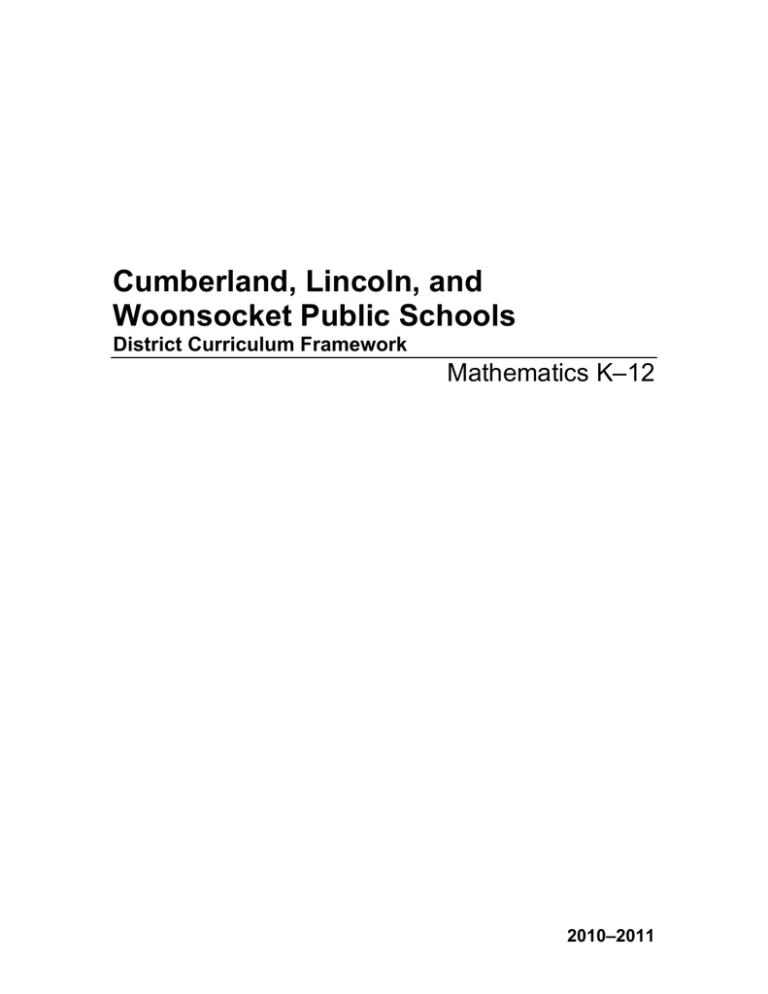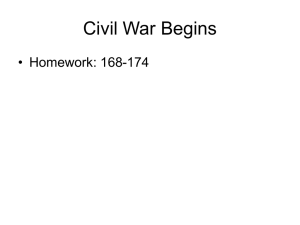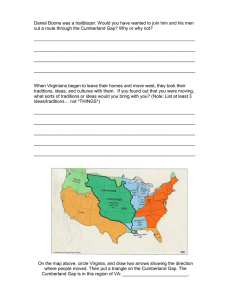Curriculum Framework - Lincoln Public Schools
advertisement

Cumberland, Lincoln, and Woonsocket Public Schools District Curriculum Framework Mathematics K–12 2010–2011 Cumberland, Lincoln, and Woonsocket Public Schools District Curriculum Framework Mathematics K–12 Who can use these documents? The processes and strategies through which these documents were developed and the overall structure and organization of these documents are the exclusive copyrighted property of the Charles A. Dana Center at The University of Texas at Austin (the University) and may not be used or distributed outside Cumberland, Lincoln, and Woonsocket public schools without written permission from the Dana Center. Unless otherwise indicated, the content of these District Curriculum Frameworks was developed through a collaboration between Cumberland, Lincoln, and Woonsocket public schools and the Charles A. Dana Center at The University of Texas at Austin. The University thus grants permission in perpetuity for this content to be used within the Cumberland, Lincoln, and Woonsocket public schools in any way the districts see fit. The content of these District Curriculum Framework documents is not intended for use or sale outside Cumberland, Lincoln, and Woonsocket public schools without express written permission from the University, which shall not be unreasonably withheld. Please send questions or permission requests to: Charles A. Dana Center The University of Texas at Austin 1616 Guadalupe Street, Suite 3.206 Austin, TX 78701-1222 Fax: 512-232-1855 dana-txshop@utlists.utexas.edu The Rhode Island mathematics Grade-Level Expectations and Grade Span Expectations constitute the foundation of these curriculum documents. These state standards, as well as released items from the New England Common Assessment Program (NECAP) and additional resources for implementing the standards, may be found at www.ride.ri.gov/instruction/curriculum, a website of the Rhode Island Department of Elementary and Secondary Education (also known as RIDE—the Rhode Island Department of Education). About the development of this resource These curriculum documents were created through a collaboration between Cumberland, Lincoln, and Woonsocket public schools and the Charles A. Dana Center at The University of Texas at Austin. This work was part of a broader statewide effort in Rhode Island, sponsored and strongly supported by the Rhode Island Department of Education (RIDE). This is the first edition of this resource. July 2010 release. Note that the materials cited in the Resources sections of these documents have been purchased by Cumberland, Lincoln, and/or Woonsocket public schools. Any opinions, findings, conclusions, or recommendations expressed in this material are those of the author(s) and do not necessarily reflect the views of The University of Texas at Austin. The Charles A. Dana Center and The University of Texas at Austin, as well as the authors and editors, assume no liability for any loss or damage resulting from the use of this resource. We have made extensive efforts to ensure the accuracy of the information in this resource, to provide proper acknowledgement of original sources, and to otherwise comply with copyright law. If you find an error or you believe we have failed to provide proper acknowledgment, please contact us at dana-txshop@utlists.utexas.edu. Frontmatter District Curriculum Framework, Mathematics K–12 Acknowledgments These curriculum documents were created collaboratively by professionals from the Cumberland, Lincoln, and Woonsocket Public Schools and the Charles A. Dana Center at The University of Texas at Austin. The Rhode Island Department of Education (RIDE) was a funder and strong supporter of this work. Rhode Island Department of Education Heather Johnson, assessment and instruction Peter McLaren, assessment and instruction Kate Nigh, assessment and instruction Mary Ann Snider, commissioner support Cumberland, Lincoln, and Woonsocket Public Schools Central Office Staff, Cumberland Public Schools Donna A. Morelle, superintendent of schools Susan Carney, assistant superintendent of schools Central Office Staff, Lincoln School Department Georgia Fortunato, superintendent of schools Melinda Smith, director of curriculum, instruction, assessment and professional development Central Office Staff, Woonsocket Education Department Robert Gerardi, superintendent of schools Linda Filomeno, director of literacy and professional development Grades K–2 Nancy Andrews, Lincoln School Department Susan Aurelio, Cumberland Public Schools Lori Beauregard, Cumberland Public Schools Loretta Carnes, Woonsocket Education Department Lori DeSimone, Lincoln School Department Deborah Duquette, Woonsocket Education Department Kelly Dwyer, Cumberland Public Schools Jessica Francis, Cumberland Public Schools Samantha Freyre, Woonsocket Education Department Angela Holt, Woonsocket Education Department Kasia Kidd, Lincoln School Department Mary Ellen Kucharski, Woonsocket Education Department Audra Laplante, Woonsocket Education Department Kelly Marini, Lincoln School Department Tanya Martins, Cumberland Public Schools Renee McCutcheon, Woonsocket Education Department Mary Lynne Miller, Cumberland Public Schools Kathy Plante, Lincoln School Department Don Poli, Woonsocket Education Department Ann Richards, Woonsocket Education Department Donna Rowland, Lincoln School Department Barbara Santos, Woonsocket Education Department Jim Zanfini, Lincoln School Department Grades 3–5 Shelly A. Allard, Lincoln School Department Shannon Bessette, Cumberland Public Schools Dianne Boisvert, Cumberland Public Schools Roxane Cary, Woonsocket Education Department Karen Costa, Lincoln School Department Jeanine Echevarria, Woonsocket Education Department ii Cumberland, Lincoln, and Woonsocket Public Schools, in collaboration with the Charles A. Dana Center at the University of Texas at Austin District Curriculum Framework, Mathematics K–12 Frontmatter Lisa Ferrucci, Woonsocket Education Department Angela Holt, Woonsocket Education Department Barbara A. Holt, Lincoln School Department Linda Iannetta, Cumberland Public Schools Paula Johnson, Cumberland Public Schools Gayle L’Esperance, Lincoln School Department Charleen Lagace, Lincoln School Department Eileen LaRiviere, Woonsocket Education Department Elizabeth Locklin, Cumberland Public Schools Paul Melaragno, Lincoln School Department Christine Parker, Woonsocket Education Department Julie Pirraglra, Woonsocket Education Department Patricia Pora, Woonsocket Education Department Christine Rivard, Woonsocket Education Department Jan Rogan Renay Sawyer, Woonsocket Education Department Susan Schaffer, Cumberland Public Schools Monique Swiszcz, Cumberland Public Schools Ann Whitelaw, Lincoln School Department Grades 6–8 Janessa Allen, Woonsocket Education Department Karen Brodeur, Cumberland Public Schools Joyce Burlingame, Lincoln School Department Kerry Carlson, Cumberland Public Schools Elizabeth Nault Costa, Cumberland Public Schools Bethany Coughlin, Cumberland Public Schools Anne Crocker, Cumberland Public Schools Lisa DeSante, Woonsocket Education Department Rebecca Ducharme, Woonsocket Education Department Kayla Emery Sue Gorrie, Woonsocket Education Department Roberta Harnois, Cumberland Public Schools Michael Manzi, Lincoln School Department Wendy McPeak, Lincoln School Department Thomas J. Mellen, Lincoln School Department Christine Mellor, Lincoln School Department Linda Murphy, Woonsocket Education Department Emily Perron, Woonsocket Education Department Peter Prendergast, Lincoln School Department Denise Queenan, Cumberland Public Schools Elizabeth R. Ramsbey, Lincoln School Department Heather Rose, Woonsocket Education Department Nicole Tetreault, Lincoln School Department Doug Wall, Lincoln School Department Kristen Lowe, Lincoln School Department High school mathematics Colleen Bibeault, Woonsocket Education Department Paula Burke, Cumberland Public Schools Jerred Dean, Cumberland Public Schools Regina Ferreira, Lincoln School Department Cheryl Gesualdi, Cumberland Public Schools Robert Gruetzke, Woonsocket Education Department Teresa Hopkins, Lincoln School Department Lisa Jacques, Woonsocket Education Department Kristen M. Jahnz, Cumberland Public Schools Cumberland, Lincoln, and Woonsocket Public Schools, in collaboration with the Charles A. Dana Center at the University of Texas at Austin iii Frontmatter District Curriculum Framework, Mathematics K–12 Nancy Koczera, Woonsocket Education Department Betsy Lachapelle, Cumberland Public Schools Michelle, Lapierre, Woonsocket Education Department Amy Laven, Lincoln School Department Michael Lemay, Woonsocket Education Department Renee Lepre, Lincoln School Department Justene Loiselle, Cumberland Public Schools Yvette Mongeon, Lincoln School Department Allison Morgan, Cumberland Public Schools Andrew Rao, Woonsocket Education Department Christopher Scott, Cumberland Public Schools Ronald St. Pere, Woonsocket Education Department Suzanne Ross Walker, Woonsocket Education Department Kathryn Williamson, Lincoln School Department Charles A. Dana Center David Hill, senior advisor Amy Dolejs, supervising editor Cara Hopkins, lead editor and production manager Joe Gallegos, senior program coordinator Bill Hopkins, research associate Carolyn Moore, mathematics consultant Joyce Polanco, mathematics consultant Karen Snow, mathematics consultant Emma Treviño, supervisor of mathematics programs Special thanks also to the following Dana Center staff writers, editors, and consultants: Steve Engler, Phillip Hebert, Rachel Jenkins, Laura Maldonado, Tom McVey, Norma Salas, Sarah Searcy, and Phil Swann. About the Building a Strong Foundation initiative Building a Strong Foundation: Improving Student Achievement in Mathematics and Science is a collaboration of the Rhode Island Department of Elementary and Secondary Education and the Charles A. Dana Center at The University of Texas at Austin. Its purpose is to increase student achievement in mathematics and science in Rhode Island public schools. The Cumberland Public Schools, Lincoln School Department, and Woonsocket Education Department are among the state’s school districts that have elected to participate in this initiative. For more information about the Building a Strong Foundation work, see the Rhode Island Department of Education website page at www.ride.ri.gov/instruction/mathsci.aspx. About Cumberland Public Schools The Cumberland Public Schools, located in Cumberland, Rhode Island (population: 30,000), serves about 5,000 students in grades kindergarten through 12. The district includes 1 high school, 2 middle schools, 5 elementary schools, and 1 preschool. For more information on Cumberland Public Schools, please visit www.cumberlandschools.org. About Lincoln Public Schools The Lincoln Public Schools, located in Lincoln, Rhode Island (population: 20,000), serves about 4,000 students in grades kindergarten through 12. The district includes 1 high school, 1 middle school, 4 elementary schools, and 2 early learning centers. For more information on the Lincoln Public Schools, please visit www.lincolnps.org. About Woonsocket Public Schools The Woonsocket Public Schools, located in Woonsocket, Rhode Island (population: 44,000) serves about 6,500 students in grades kindergarten through 12. The district includes 1 high school, 1 high school-level career and technical center, 2 middle schools, and 9 elementary schools. For more information on the Woonsocket Public Schools, please visit www.woonsocketschools.com. iv Cumberland, Lincoln, and Woonsocket Public Schools, in collaboration with the Charles A. Dana Center at the University of Texas at Austin District Curriculum Framework, Mathematics K–12 Frontmatter About the Charles A. Dana Center at The University of Texas at Austin The Dana Center works to raise student achievement in K–16 mathematics and science, especially for historically underserved populations. It does so by providing direct service to school districts and institutions of higher education; to local, state, and national education leaders; and to nonprofits, agencies, and professional organizations concerned with strengthening American mathematics and science education. The Center is committed to ensuring that the accident of where a child attends school does not limit the academic opportunities he or she can pursue. For more information and to access Center resources (many of them free), please see www.utdanacenter.org. Cumberland, Lincoln, and Woonsocket Public Schools, in collaboration with the Charles A. Dana Center at the University of Texas at Austin v Frontmatter vi District Curriculum Framework, Mathematics K–12 Cumberland, Lincoln, and Woonsocket Public Schools, in collaboration with the Charles A. Dana Center at the University of Texas at Austin District Curriculum Framework, Mathematics K–12 Frontmatter Mathematics K–12 District Curriculum Framework Table of Contents Introduction .................................................................................................................................................. 1 Section A: Scope and Sequence ............................................................................................................... A-1 Section B: Year at a Glance: Units of Study by Quarter .......................................................................... B-1 Section C: Units of Study ........................................................................................................................ C-1 Section D: Rhode Island Mathematics K–12 GLEs and GSEs ............................................................... D-1 Cumberland, Lincoln, and Woonsocket Public Schools, in collaboration with the Charles A. Dana Center at the University of Texas at Austin vii Frontmatter viii District Curriculum Framework, Mathematics K–12 Cumberland, Lincoln, and Woonsocket Public Schools, in collaboration with the Charles A. Dana Center at the University of Texas at Austin District Curriculum Framework, Mathematics K–12 Frontmatter Cumberland, Lincoln, and Woonsocket Public Schools Building a Strong Foundation School Year 2010–2011 Overview Purpose: Increase student achievement in mathematics in Cumberland, Lincoln, and Woonsocket Public School Districts by aligning curriculum, instruction, and assessment to the state standards. Objectives: Actions: Roles and Responsibilities: 1. Implement the guaranteed and viable curriculum every day, in every classroom, for every student. Teachers, leaders, and Charles A. Dana Center staff will: 2. Provide regular opportunities for teachers and leaders to collaboratively study and implement the curriculum. Central office staff will… Provide monitoring and support of curriculum development and implementation, collaborate with teacher writing team members and Dana Center staff, and ensure that the work of the initiative is aligned to the district’s overall plan for increasing student achievement in mathematics. 3. Implement routines and structures for monitoring implementation of the curriculum and providing feedback. a. Collaboratively generate district-level curriculum documents that delineate which GSEs (Grade Span Expectations) and GLEs (Grade-Level Expectations) should be taught in each grade level, in what order, and for what duration. b. Engage in system-wide study of the state standards and district-developed curriculum documents. c. Develop and implement support structures and tools for leaders to increase their ability to support teachers in implementing the district curriculum. d. Refine and implement support structures and tools for teachers as they work collaboratively to plan and implement instruction that is aligned to the state standards and district curriculum. Building leaders will… Ensure teacher participation in professional development, provide regular opportunities for teachers to collaboratively plan and implement instruction aligned to the standards and curriculum, monitor implementation of the curriculum, and provide teachers with ongoing meaningful feedback. Teachers will… Attend and actively participate in professional development, implement the curriculum in every classroom for every child on every day, and regularly collaborate with grade level/department colleagues to plan and implement instruction aligned to the standards and curriculum documents. The Charles A. Dana Center at the University of Texas at Austin will… Provide technical expertise and on-site support for planning and implementing this work, facilitate the initial alignment work, and help Cumberland, Lincoln, and Woonsocket Public School Districts build capacity in their systems throughout this project. Cumberland, Lincoln, and Woonsocket Public Schools, in collaboration with the Charles A. Dana Center at the University of Texas at Austin ix Frontmatter District Curriculum Framework, Mathematics K–12 Developing the Guaranteed and Viable Curriculum Research* concludes that implementation of a guaranteed and viable curriculum plays a critical role in improving student achievement. Guaranteed means that every child in every school receives essential instruction every day; viable means that the curriculum can be taught in the amount of time provided. The District Curriculum Frameworks developed in this collaboration between Cumberland, Lincoln, and Woonsocket public schools and the Dana Center outline the guaranteed and viable curriculum and define the essential knowledge that all students must learn in mathematics at each grade level and in each course of study. Careful attention was given to the amount of time necessary to teach these essential knowledge and skills. This guaranteed and viable curriculum for Cumberland, Lincoln, and Woonsocket public schools was developed through careful study of—and alignment to—the state standards (the Rhode Island Grade Span Expectations, or GSEs, and Grade-Level Expectations, or GLEs). This process of starting from state standards to identify essential student learning is referred to as backloading. The backloading process supported the development of the scope-and-sequence document for each grade level or course. Teacher representatives from every grade level and course taught in the district worked in teams (K–4, 5–8, and 9–12) to determine which standards would be taught in each quarter for each grade level or course from kindergarten through grade 12. In addition, the teacher teams clustered standards into “big idea” groups called units of study. The teacher teams, working in collaboration with Dana Center staff, made the decisions about which standards best clustered together for each unit and in what sequence the units should be taught. For mathematics, they made these decisions based on the GLEs/GSEs and research from Principles and Standards for School Mathematics, A Research Companion to Principles and Standards for School Mathematics, and Numeracy in Mathematics. Structure of the District Curriculum Framework The purpose of these district curriculum documents is to support quality implementation of the Rhode Island mathematics GSEs and GLEs every day, in every classroom, for every student—to ensure gradelevel and subject-area alignment and coherence across the district. In the District Curriculum Framework documents for mathematics, we have tried to identify which standards are taught, when, and for how long. We have also tried to clarify standards and describe the implications of the standards for each grade level or course. The District Curriculum Framework documents do not provide daily lesson plans, eliminate the need for lesson planning, or recreate the teacher’s edition of classroom resources. Rather, the curriculum framework provides a workplan that directs the instruction delivered in every classroom in every school in the district. The curriculum framework consists of the following sections. Section A: Scope and Sequence This section includes the relevant content standards (GSEs/GLEs) taught in each unit of study, organized by quarter. * See, for example, Chapter 3, A Guaranteed and Viable Curriculum, pages 22–34 in Robert J. Marzano’s What works in schools: Translating research into action. Alexandria, VA: Association for Supervision and Curriculum Development, 2003. x Cumberland, Lincoln, and Woonsocket Public Schools, in collaboration with the Charles A. Dana Center at the University of Texas at Austin District Curriculum Framework, Mathematics K–12 Frontmatter Section B: Year at a Glance: Units of Study by Quarter This section lists the title of each unit of study for that grade or course along with the number of days needed to conduct the unit. Section C: Units of Study Important Note: The units of study are currently being developed by teams of educators from Cumberland, Lincoln, and Woonsocket public schools, with support from the Dana Center. This section will be completed as the units are completed prior to the beginning of each quarter in the 2010–2011 school year. These instructional units outline specific student outcomes aligned to the GSEs/GLEs. These units are the heart of the District Curriculum Framework documents. Each unit of study provides detailed information to support lesson planning and is structured in two main sections: • Overview: Each one-page unit overview lists the total number of days needed to teach the unit and defines expectations for student learning by articulating the content to be learned and processes to be used—that is, the standards-based expectations of which students will demonstrate understanding. The overview ends with a list of the Essential Questions that students should be able to answer by the end of the unit. • Written curriculum: This section lists the specific parts of the relevant mathematics GSEs/GLEs to be taught during the unit. The Clarifying the Standards subsection provides an analysis of the ideas taught in the grade level(s) before (Prior Learning) and after (Future Learning) the grade level or course being taught. This subsection also clarifies what should be learned in the current grade level or course and reports important findings from research and the standards that support teachers in narrowing the idea in the standards to the content taught in the grade level. Section D: Rhode Island Mathematics K–12 GSEs/GLEs These are complete copies of the state standards for mathematics, to aid in effective collaboration around the District Curriculum Framework documents. Cumberland, Lincoln, and Woonsocket Public Schools, in collaboration with the Charles A. Dana Center at the University of Texas at Austin xi Frontmatter xii District Curriculum Framework, Mathematics K–12 Cumberland, Lincoln, and Woonsocket Public Schools, in collaboration with the Charles A. Dana Center at the University of Texas at Austin


